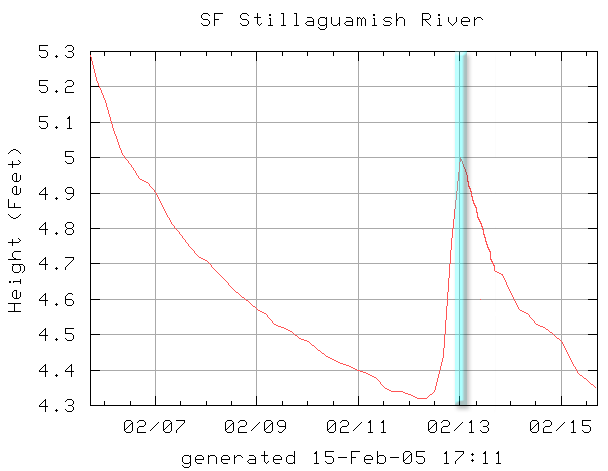
Robe is one of the 'must-do' rivers for hard-core Northwest class five paddlers. The rapids are big and hard, and the canyon is awe-inspiring. Some of the local pro kayakers ( Tao Berman, etc ) have been known to run Robe a couple of times in one day, but for most mere mortals one trip down is enough to torch the adrenaline glands. If you have ever wanted to kayak in Nepal but can't afford a ticket, this might be the run for you. Robe's huge granite boulders, towering walls, and glacial silt-laden water bring to mind the mighty rivers of the Orient.
The Bennett guidebook description sums Robe up this way: "The rapids seem to go on forever.. Robe Canyon is not for part-time class V paddlers."
Pete Giordano and I wandered up to the South Fork Stillaguamish ( known locally as the 'South Stilly' ) drainage in February 2005. Oregon was wilting under the most heinous drought any of us could remember, caused by a strong El Nino event that was diverting all of the big rainstorms south to California or north to Washington State. The local paddling web forums were filled with semi-hysterical lamentations on the lack of rain, and we finally decided that we had to go find the water, it certainly wasn't going to come to us!
The South Stilly is located due east of Everett Washington, which is just north of Seattle. It is about a four hour drive from Portland, on freeways the whole way. This makes Robe a reasonable weekend trip for Portland paddlers looking for an alternative to their 8,569th lap on the Little White Salmon. We drove up on a Friday night and camped, excited about a weekend of paddling after such a long dry spell. There are lots of rivers and creeks near Robe, so on Saturday morning we ran the Sultan River, then hopped over into the Stillaguamish drainage and ran the short but fun Canyon Creek gorge.
Saturday night a rainstorm materialized as predicted, giving Robe a hoped-for bump as we headed up into the canyon. Arriving at the take-out bridge, we peered down into the gorge and wondered how in the heck we were going to get out of there at the end of the day. Finally we decided some determined scrambling and ropework would get the job done, so we dropped Pete's Moped off and headed upriver. (Ask Pete sometime about running the class V shuttle on the Moped through nine miles of ice and snow at the end of the day. Boy, did he get some looks from people coming down from Barlow Pass.. )
Pete Giordano at the put in for Robe Canyon.
Paddlers have a couple of options for a put in on Robe. The entire section is twelve miles long, but the crux canyon is only about three miles. So, you can drive up to Verlot and paddle five miles of class I-II before the canyon, or you can hike in about a mile and put in at Tunnel rapid. We opted for the five-mile warm up, which actually went fairly quickly.
We arrived at the entrance to Robe, signaled by a dramatic narrowing of the river and a thunderous roar. We ran the first relatively small lead-in drop, then got out above what could only be 'Tunnel' rapid, the first of the really big drops in the canyon. There is an old path that used to be a railroad track that runs along the river-right wall, so I scouted from that side, while Pete scouted from the left.
Tunnel consists of two sections. The first has a large hole in the center of the river, followed by a steep pile of huge granite boulders that funnels you down between ever-narrowing walls.
The mood got very serious at this point. Both of us could see that options were limited if something went wrong. "Alright, it's game on." Pete said..
Pete (river left, yellow drysuit) returns from scouting the second part of Tunnel Rapid, the first in a series of large rapids in Robe Canyon.
Pete Giordano enters Tunnel Rapid. This drop leads directly into the section shown in the photo above; both photos were
taken from the same spot.
Below Tunnel rapid the river roared around the corner to the right with another big, tough rapid. This was how the first mile or two seemed to go, just one large class V rapid after the other, with huge moving pools between the drops. Many of the rapids had severe consequences for a missed line like a boulder sieve or huge hole, so it wasn't exactly a low-stress kind of day for us.
Pete below the third rapid in Robe, I think this one is called 'Trap Door'.
Pete cruises through some of the relatively mellow whitewater between the big stuff.
Wah hoo!
Eventually we arrived at a very long rapid and got out for the scout on the left. Pete got to the bottom first, and I could tell by how much time he was spending that there was a little somethin'- somethin' down there..
When I arrived I found him peering into a large, sticky-looking hole with a log wedged in the right hand side. After a little more contemplation, Pete gave me the thumbs up and headed back upstream to give 'er a go. I found the best spot I could see to set safety, came up with a plan, and settled down with the camera and a rope.
Finally, Pete came charging down, hit his line perfectly, and dropped into the bottom hole, which stopped him cold. He got a big back-ender out of the hole, and as he was going over he lunged downstream and grabbed the outflow, which carried him free of the hole, upside-down. Whew!
Pete Giordano charges through 'Hotel California'.. The hole at the bottom of this drop was very powerful.
Downstream were more rapids, one of which flowed into a large, cement remnant from the railroad structure that formed a do-or-die move on the right, so we seal-launched around it on the left hand side.
Pete runs a drop called 'Catchers Mitt'. At this point, I was pretty confused about which rapid
was which, so I kept annoying Pete with questions like: "Hey, do you think THIS looks like a rapid someone would name 'Splatterpuss' ?!?"
Soon we arrived at what could only be Landslide rapid. Here it looks like the entire right-side canyon wall collapsed at some point, filling the river with a gigantic pile of orange boulders. We got out on the right and started working our way through the portage / scout, because the lower half actually turned out to be runnable.
Pete portaging Landslide, a hideous drop formed by a pile of boulders blocking the river.
Just below Landslide was another sketchy looking drop ( I think called 'Garbage' ) that I put in below but Pete ran without problems. Below Landslide were a few more big rapids, and lots of fun class III-IV in between, some really good stuff. Gradually the canyon opened up, and there was a mile or so of flat water, which was a little bit of a drag, considering the long paddle-in we had started the day with. The run does end with a bang at the end with the boulder garden at the take-out bridge, and then we spent the next twenty minutes roping the boats up the cliff (save some energy for the take-out!).
FLOWS:
The internet gauge flows the day the photos in this trip report were taken are shown below, the river rose to five feet while we were on it. Optimal flows are around 5 - 5.5 feet, though paddlers do run the river down into the 4 - 4.5 foot range. We were coming off of a big rainstorm, so we had a healthy flow. Six feet and above is considered high water on this run, though in 'Twitch 2000' Tao and company run Robe at flood, so extreme high-water runs are at least theoretically possible..
Robe runs November through May, from rain in the winter and snowmelt in the Spring.
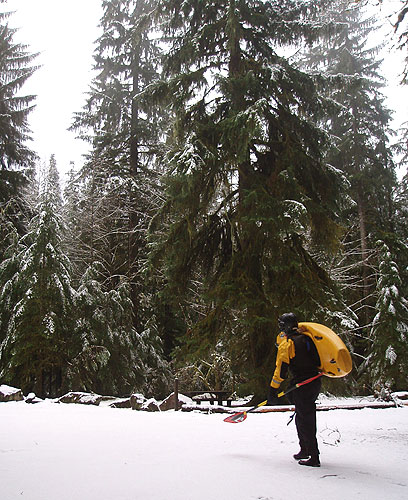
About
half of the rapid is visible in this photo.
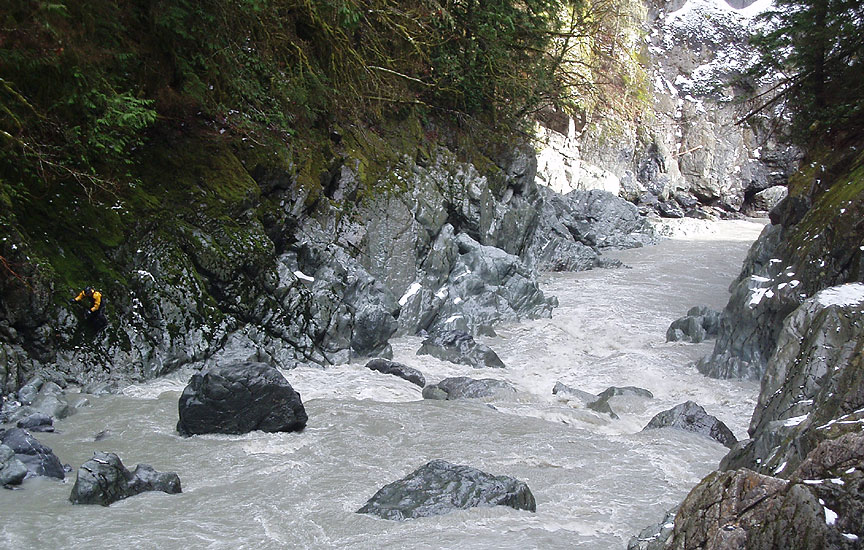
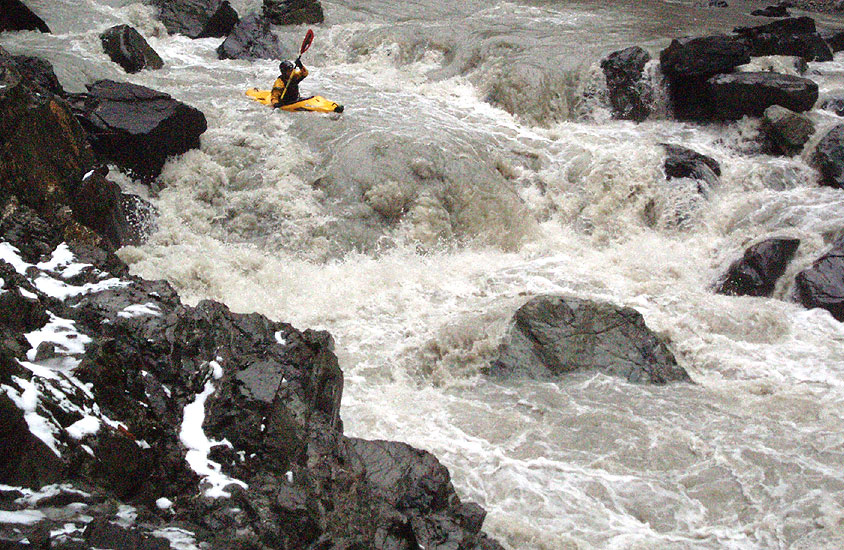
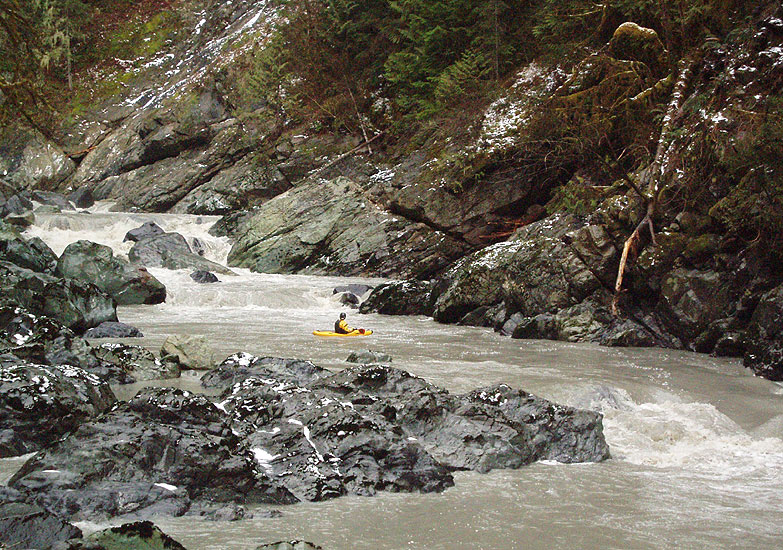
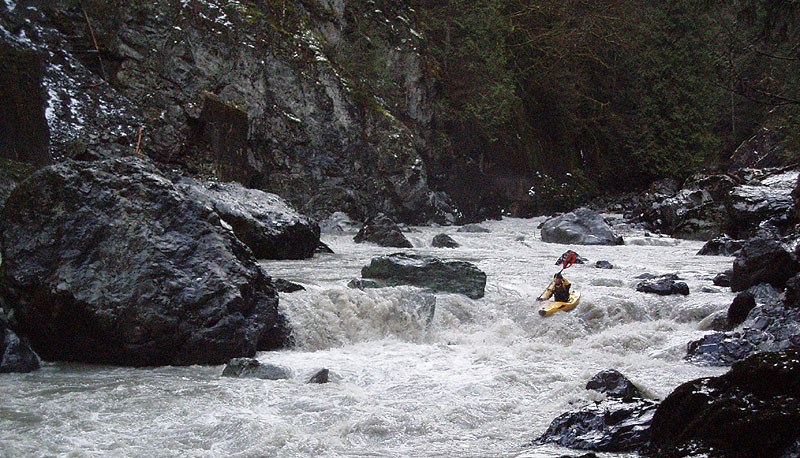
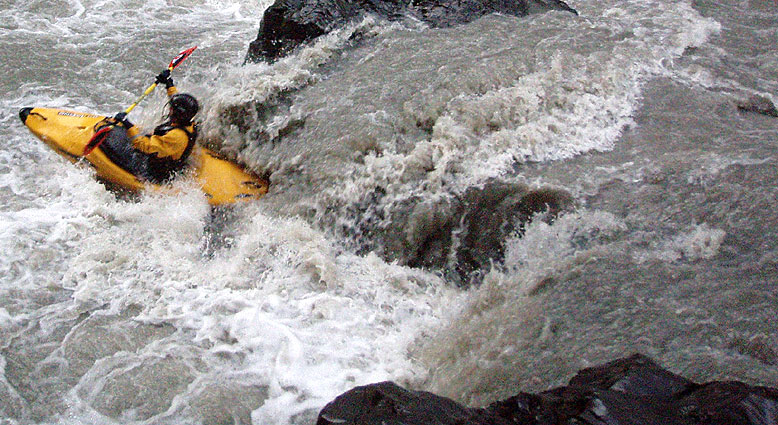
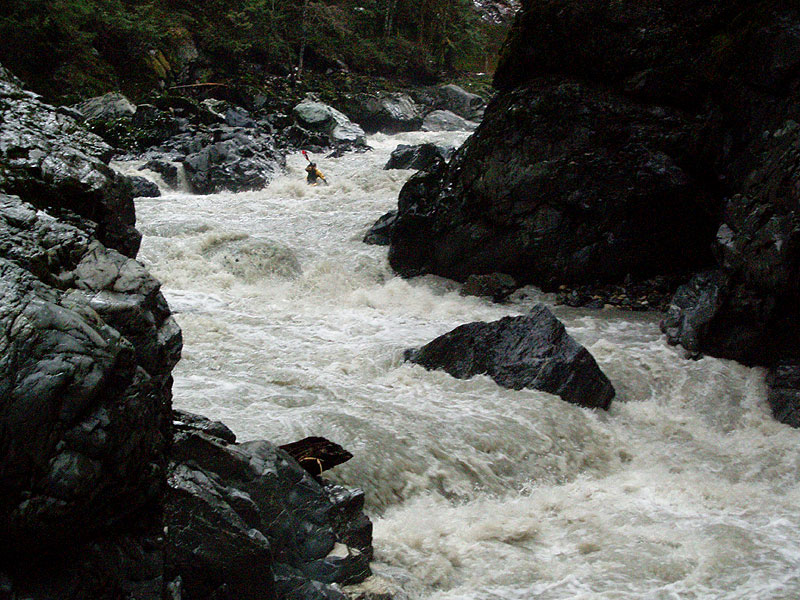
Perhaps a local can correct me if I'm wrong.
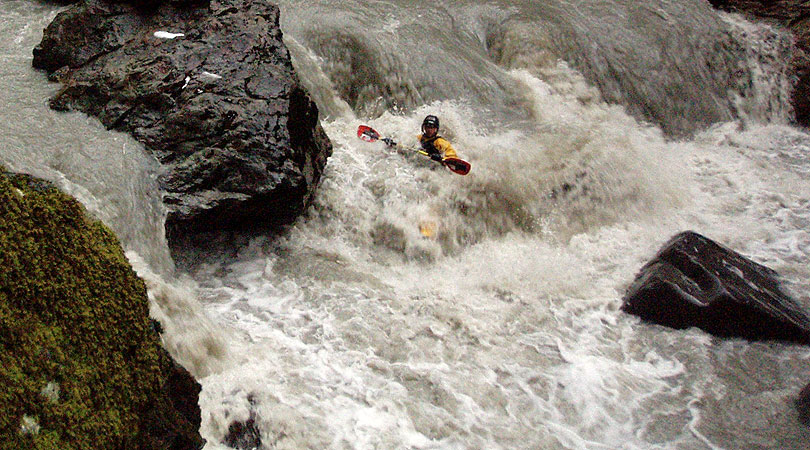

ACCESS: Robe is located slightly northeast of the city of Everett, which is just north of Seattle, Washington. It is about a 4.5 hour drive from Portland, Oregon. Pick up the Guide to the Whitewater Rivers second edition by Jeff Bennett for more information.
